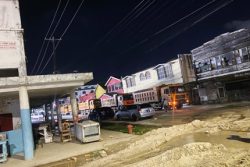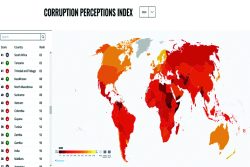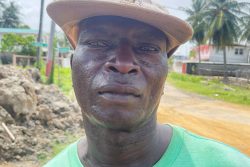By Janette Bulkan
On your way to or from Guyana’s international airport at Timehri you travel on the East Bank Demerara road. Every mile or so, a small billboard displaying the village name will flash past your eyes. 29 kms from Georgetown and 10.5 km from Timehri is ‘Te Huis Te Coverden’, [‘the house in Coverden]’, ‘Coverden’ being the anglicised version of ‘Coevorden’ [Cow Borden] in Dutch. ‘Coevorden’ is a place in the Netherlands, a reminder that Guyana was a Dutch colony, indeed for more years than it was an English colony.
Guyanese shorten names: just as ‘pine-apple’ is ‘pine’, so ‘Te Huis Te Coverden’ is ‘Coverden’ to its citizens. Most of the village lands lie east of the road whose alignment closely parallels the Demerara River. The 2012 census (Guyana’s last census) reported Coverden’s population at 459 persons in 151 households. Land tenure was 90% ‘owned/freehold’; 136 of the 151 households owned their house lots. In 2012, 54% of its population identified as ‘African/Black’, 31% as ‘Mixed’ and 13% as East Indian. In the national consciousness, it would be fair to say that the average Guyanese would describe Coverden as being a Black village, on the basis of its ethnic composition.
Citizen Audreyanna Thomas (as she signs her name) of Coverden learned from reading a newspaper that Guyana’s EPA had waived the requirement for ‘Global Oil Environmental Services’ (GOES) to conduct an environmental impact assessment (EIA) in her village (Kaieteur News, 25 March, 2021, ‘US logistics company to set up EBD Waste Treatment Facility’). Citizen Audreyanna Thomas learned that GOES was constructing and would operate a waste treatment facility for the transfer, storage, treatment, and disposal of Exploration and Production (E&P) oil & gas waste in Coverden.
Coverden residents were only the latest in a line of affected communities not consulted by the EPA before the issue of waivers. Coverden’s prime location on the right bank of the Demerara River is its twin blessing and curse. The riverside property acquired by GOES is on freehold titled land which provides the widest tenure rights to its owner. It is also in a Mixed Commercial Zone. The residents of Coverden need the EPA, a government agency, to follow the prescriptions in the Environmental Protection Act 1996 (EP Act) to safeguard their interests and uphold the assurance of Article 36 in our National Constitution – ‘the well-being for the nation depends upon preserving clean air, fertile soils, pure water and the rich diversity of plants, animals and eco-systems’.
Here is how Citizen Audreyanna Thomas described Coverden, her natal village, in her letter (Stabroek News 26 March 2021):
‘Editor, I was born and grew up in Coverden. My family owns about a quarter of that village and we have been residing there since 1842, according to official records; over 178 years. I still have possibly about 200 blood-relatives who live there, so this is a very personal matter. … I also have several family members and another over 150 years family history, as well as friends and other families on the West Bank of the Demerara River, immediately behind and obliquely opposite Coverden … These are communities that do not have electricity nor potable water, therefore they use the water from the Demerara River for domestic use, for example, washing clothes. They use water from the canal for drinking and cooking purposes; some of them also do rainwater harvesting. I grew up washing my clothes in the Demerara River and drinking water from the Canal. The water was also used for cooking.’
In their letters to the press and in presentations at public hearings convened by the Environmental Assessment Board (EAB), Thomas and other villagers paint a picture of Coverden as ancestral land, continuously inhabited for a century and three-quarters by blood kin. Coverden is sacralised space, land that was sold in the colonial era to mostly absentee plantation owners, then worked with the sweat and toil of African slaves. Their blood and bones have enriched the coastland that is home to the majority of Guyanese. After Emancipation in 1834, freed Africans pooled their savings to purchase abandoned estates; this was likely how Te Huis Te Coverden Village began in 1842.
In their reported statements from 26 March onwards, Thomas and other Coverden villagers show us that the vast number of households remain partly dependent on a subsistence economy. Their lives and living depend on ‘Nature’s Bounty’, on unpolluted soil and air and river and ground water. Guyana’s EP Act entrusts the Environmental Protection Agency (EPA) to protect the citizens of Coverden, and all Guyanese from ‘adverse effect’ (Section 2) that includes: ‘(c) harm or material discomfort to any person; (d) an adverse effect on the health of any person; (e) impairment of the safety of any person … (g) loss of enjoyment of normal use of property.’
Two weeks following Thomas’ letter, Stabroek News reported on 15 April 2021 that ‘the EPA had informed the public of the proposed project on April 6 via a notice and had stated that it was screened and determined by the agency that the project will not significantly affect the environment or human health and so is therefore exempt from the requirement of an Environmental Impact Assessment (EIA)’.
The EP Act refers frequently to ‘significant effects’ but does not define the term. Section 16 empowers the Minister to make regulations establishing the criteria and thresholds to determine which project may have significant effects on the environment. Regrettably, the general Regulations 2000 of the EPA do not include such criteria or thresholds. However, the EPA has referred frequently to a screening procedure which appears to correspond to the criteria provided for in the EP Act. As it has done in a range of waivers over the past year, the EPA said that it used that unpublished in-house project screening procedure to determine that an EIA was not required for the GOES project in Coverden and that its final score fell below the pre-set thresholds under that procedure.
The citizens’ right of access to that now-secret screening procedure, which appears to correspond to the criteria provided for in the EP Act, section 16) is assured in Articles 4(4) and 5 of the Escazú Agreement 2018, (ratified by Guyana in 2019). The Escazú Agreement should allow access by citizens not only to this screening procedure but to all other documents related to participation and justice in the management of the environment.
In addition, the EPA did not comply with the requirement set out in the EP Act section 11(2)(a/b) – to provide the reasons for its decision on whether or not an EIA is required. While neither the GOES proposal, nor the proposal from Non Destructive Testers, another Coverden-based company providing services to the oil and gas industry, (to be discussed in a subsequent article), is covered by schedule 4 of the EP Act which automatically requires an EIA, they are covered by section 11(1) line 2 of the Act. The EPA was therefore in violation of its Act by disregarding its own legislation.
According to the Stabroek News article of 15 April 2021, Coverden residents sent two formal appeals to the EPA protesting the lack of consultation on this major construction project [GOES] in their community. ‘In keeping with EPA regulations and as property owners in the area, [they] are requesting an immediate hold on the approval for the construction of the facility unless and until several Town Hall meetings are held by the relevant authorities or agencies with the communities to be affected. According to the letter, this is to evaluate the new development on its future economic, cultural and social impacts upon those communities. In addition, they requested that it be halted until specific assessments are done and published by the relevant authorities or agencies’.
The Environmental Assessment Board is the body created by the EP Act to hear appeals against EPA decisions. A month after the EPA’s notification of its waiver of an EIA, on 10 May 2021 the Environmental Assessment Board (EAB) facilitated an in-person public hearing at the local government office (located only 4 kms from Coverden) regarding the construction and operation of the GOES waste treatment facility. GOES representative Perry Colwart then disclosed to the residents that his company ‘will be handling effluents that can be very impactful on the environment, such as hydrocarbons. He noted while there are several technologies available in Guyana which deal with such types of waste, none can handle the volume for a long term period, which is why the company finds it critical to establish such a facility in the areas. He said that the reselling of these hydrocarbons will have tremendous benefits to not only Coverden residents but Guyana as well’.
Since, according to Colwart, the GOES facility on completion would have a total of 12 employees – five Americans and seven Guyanese – it is unlikely that Coverden residents would experience any positive benefits from employment. Rather, much like Indigenous communities in Guyana’s hinterland, they will have to bear silent witness to the transformations wrought by others on their ancestral village land, and with no reference to them.
Stabroek News reported on 14 June 2021 that a second hearing had been held virtually on 18 May 2021 into the appeals submitted against the GOES project. At the conclusion, the EAB confirmed the EPA’s decision to waive an Environmental Impact Assessment (EIA) for GOES. To date, neither the EPA’s nor the EAB’s rationale for the waiver is in the public domain, contrary to the EP Act.
But GOES is not the only part of the supply chain of the petroleum industry approved for location and operation in Coverden without the prior and informed consent of its residents. Even before the EAB’s confirmation of the EPA’s waiver of an EIA for GOES, Coverden residents learned from a newspaper article on 1 June 2021 that the EPA had waived the need for an EIA for a Trinidadian company, Non Destructive Testers, to store a radioactive source at Coverden, and to operate from that base. I will take up that story in my next article.
It is worth noting that Coverden residents have not said ‘no’ to GOES or to oil and gas companies located in their village. Instead they speak about the need for information on risks, to be recognized as affected stakeholders with a right to be consulted and to give or withhold consent to major infrastructure developments, and to derive benefits. In Thomas’ words: ‘I would therefore strongly recommend that the …EPA ensures that an Environmental and Social Impact Assessment (EISA) is done before this facility is approved and that the community is engaged considerably in this process. I look forward to receiving my invitation to these meetings. Here are some of the reasons why an ESIA is absolutely necessary; many of these residents are engaged in cash crop farming, they also have kitchen gardens as a means of livelihood; as such, when there is high (spring) tide, some of the communities on the western side of the Demerara River floods, bringing water onto the lands into the farms and kitchen gardens. Residents need to be aware of the potential dangers of this waste treatment facility. What chemicals will be used and discharged into the river, if any? What quantities will be discharged? What chemicals will be stored at the facility? What are the possible impact on their crops, livelihoods, health, environment, etc., additionally, if there is a chemical spill, waste leakage, how would it impact on the 178 years lifestyle of the residents of this community? How will it affect the ground water and surface water? It has been my experience, as a child, to witness water from the Demerara River penetrating through trenches/canals to farmlands and the East Demerara Water Conservancy aka ‘the conservancy’; this occurs especially when there are issues with the kokers’.
As Audreyanna Thomas’ questions have not been answered by the EPA, we are left to wonder what values take precedence for the EPA: an intact and resilient environment or a high-risk environment? Collaboration with the local community that can be the Agency’s eyes and ears or collaboration only with powerful industrial companies? Actions speak louder than words.
Vice-President Bharrat Jagdeo is leading the joint delegation from Guyana and Suriname to the COP26 meeting on climate change at Glasgow, UK, in November. The Vice-President is reported in SN as saying that he will be referring to Guyana’s managed natural environment as a positive contribution to the global climate. Leaving aside the inaccuracy of the Vice-President’s claim, that is surely inconsistent with preventing citizens of Guyana from even knowing the risks associated with new industrial installations to handle the wastes from climate-destroying petroleum production.
Dr Janette Bulkan is an Associate Professor in the Department of Forest Resources Management in the Faculty of Forestry, University of British Columbia, Canada. She was Senior Social Scientist at the Iwokrama International Centre for Rainforest Conservation and Development from March 2000 – March 2003.







